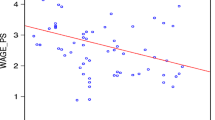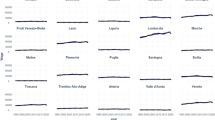Abstract
Do public sector wages have an influence in the determination of private sector wages? This article tries to isolate the pure signalling effect that one sector might exert on the other by controlling for other determinants of wages (prices, productivity, institutions) for the main euro area economies (Germany, France, Italy and Spain) and the periods 1980–2007 and 1991–2007. It exploits available quarterly information not yet used in the literature, and combines different data sources in the framework of mixed-frequencies time series models. The quarterly frequency of our data allows us to decompose the casual effects into purely intra-annual effects and across-years effects. Our conclusions establish the existence of purely intra-annual links between public and private sector wages (signalling effect). There is strong evidence of public wages’ leadership, either in conjunction with bi-directional links from the private sector (Spain, Italy) or pure public sector leadership (Germany and France in the sample 1991–2007). Our empirical approach allows us to also unveil a complex and rich structure of indirect links of wages with other variables (prices, productivity and institutional factors).
Similar content being viewed by others
References
Afonso A, Gomes P (2008) Interactions between private and public sector wages. European Central Bank Working Paper 971, November
Alesina A, Ardagna S, Perotti R, Schiantarelli F (2002) Fiscal policy, profits and investment. Am Econ Rev 92: 571–589
Algan Y, Cahuc P, Zylberberg A (2002) Public employment: does it increase unemployment. Econ Policy 34: 7–65
Ardagna S (2007) Fiscal policy in unionized labor markets. J Econ Dyn Control 31: 1498–1534
Conway P, Nicoletti G (2006) Product market regulation in the non-manufacturing sectors of OECD countries: measurement and highlights. OECD Economics Department Working Paper, No. 530
Christou C, Klemm A, Tiffin A (2007) Wage Dynamics in the Romanian Economy. IMF Article IV, Selected Issues, pp 34–50
Demekas DG, Kontolemis ZG (2000) Government employment and wages and labour market performance. Oxf Bull Econ Stat 62: 391–415
Demiralp S, Hoover KD (2003) Searching for the causal structure of a vector autoregression. Oxf Bull Econ Stat 65(Suppl.): 745–767
Dreher A, Gaston N, Martens P (2008) Measuring globalization–gauging its consequences. Springer, New York
Eichler M (2007) Granger causality and path diagrams for multivariate time series. J Econom 137: 334–353
Feldstein MS (2008) Did wages reflect growth in productivity?. J Policy Model 30: 591–594
Freeman DG, Yerger DB (2000) Does inflation lower productivity? Time series evidence on the impact of inflation on labor productivity in 12 OECD nations. Atl Econ J 28: 315–332
Friberg K (2007) Intersectoral Wage linkages: the case of Sweden. Empir Econ 32: 161–184
Garrett I, Priestley R (2000) Dividend behavior and dividend signaling. J Financ Quant Anal 35: 173–189
Harvey A (1989) Forecasting Structural Time Series Models and the Kalman Filter. Cambridge University Press, UK
Harvey A, Chung C (2000) Estimating the underlying change in unemployment in the UK. J R Stat Soc A 163: 303–339
Holmlund B, Ohlson H (1992) Wage linkages between private and public sectors in Sweden. Labour 6: 3–17
Jacobson T, Ohlsson H (1994) Long run relations between private and public sector wages in Sweden. Empir Econ 19: 343–360
Johansen K, Strom B (2003) Efficiency wages, wage comparison, and public sector budgeting. Econ Gov 4: 215–228
Kuhn P, Gu W (1999) Learning in sequential wage negotiations: theory and evidence. J Labor Econ 17(1): 109–140
Lamo A, Pérez JJ, Schuknecht L (2008) Public and private sector wages: co-movement and causality. European Central Bank Working Paper 963, November
Lange J, Sack B, Whitesell W (2003) Anticipations of monetary policy in financial markets. J Money Credit Bank 35(6, Part 1): 889–909
Lauritzen SL, Richardson TS (2002) Chain graph models and their causal interpretations. J R Stat Soc B (Stat Method) 64: 321–361
Lindquist J, Vilhelmsson R (2006) Is the Swedish central government a wage leader?. Appl Econ 38: 1617–1625
Maffezoli M (2001) Non-walrasian labor markets and real business cycles. Rev Econ Dyn 4: 860–892
Mizala A, Romaguera P (1995) Testing for wage leadership processes in the Chilean economy. Appl Econ 27: 303–310
Nickell W (2006) The CEP-OECD institutions data set (1960–2004). CEP Discussion Papers dp0759. Centre for Economic Performance, London School of Economics
OECD (1997) Measuring public employment in OECD countries: sources, methods and results, Paris
Pedregal D, Pérez JJ (2009) Should quarterly government finance statistics be used for fiscal surveillance in Europe? Int J Forecast. doi:10.1016/j.ijforecast.2009.08.002
Proietti T, Moauro F (2006) Dynamic factor analysis with non-linear temporal aggregation constraints. J R Stat Soc C, R Stat Soc 55: 281–300
Ram R (1984) Causal ordering across inflation and productivity growth in the post-war United States. Rev Econ Stat 66: 472–477
Strom B (1997) Envy, fairness and political influence in local government wage determination: evidence from Norway. Economica 62: 389–409
Tagtstrom S (2000) The wage spread between different sectors in Sweden. Sveriges Riskbank Econ Rev 4: 77–82
Toda HY, Yamamoto T (1995) Statistical inference in vector autoregressions with possibly integrated processes. J Econom 66: 225–250
Tyler JH, Murnane RJ, Willett JB (2000) Estimating the labor market signaling value of the GED. Q J Econ 115: 431–468
Weiss A (1995) Human capital vs. signalling explanations of wages. J Econ Perspect 9: 133–154
Author information
Authors and Affiliations
Corresponding author
Rights and permissions
About this article
Cite this article
Pérez, J.J., Sánchez, A.J. Is there a signalling role for public wages? Evidence for the euro area based on macro data. Empir Econ 41, 421–445 (2011). https://doi.org/10.1007/s00181-010-0380-9
Received:
Accepted:
Published:
Issue Date:
DOI: https://doi.org/10.1007/s00181-010-0380-9




